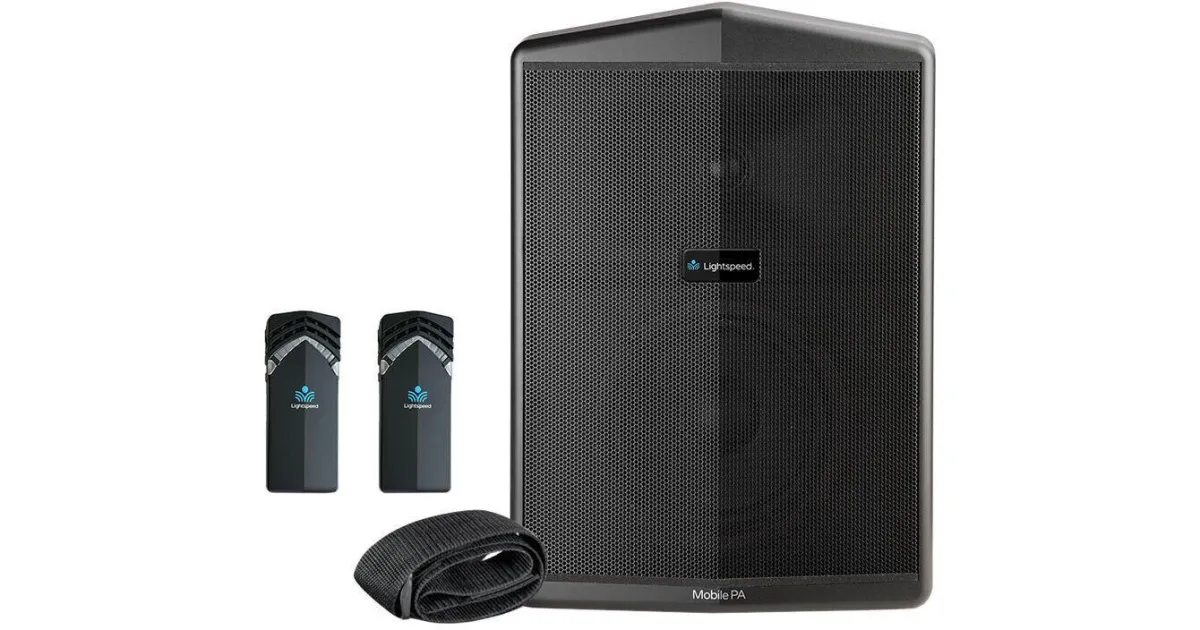
Mobile Audio for Physical Education Classes
Effective communication is essential for physical education teachers to engage and
teach their students. P.E. teachers work with diverse groups, often with varying
language backgrounds and ability levels, in both indoor and outdoor settings.
Clear verbal and nonverbal communication build trust and respect, making students feel
heard and helping them more effectively develop motor skills. It also supports in class
management and delivering clearer instruction. Mobile instructional audio systems can
increase communication effectiveness, boosting motivation, performance, and overall
classroom connection for all students.
Instructional audio refers to wireless audio systems that evenly distribute a speaker’s
voice throughout a space via an amplifier and speaker, making it easier for students to
hear and comprehend a teacher’s instruction. The Lightspeed Mobile PA, is a portable,
all-in-one system that provides flexibility for both indoor and outdoor use. This “grab
and go” system includes a wireless microphone that teachers and students use to
amplify their voices. It also includes Bluetooth technology.
During their instruction, physical education teachers frequently turn their bodies and
voices away from students, making it difficult for students to hear what they’re saying.
At the same time, noise from scuffling feet, bouncing balls, or chatter from other
students can quickly muffle and fatigue a teacher’s voice. Just as students rely on a
teacher’s voice in a traditional classroom for success, the same is true in physical
education classes.
Research over the past 40 years has highlighted the critical link between hearing clearly
and learning. Children need to hear at least 90 percent of what is said by their teachers
to fully absorb the information, and young students, particularly those aged 6 to 9, often
struggle to distinguish voices amid background noise. In educational
settings–especially in physical education, where noise from activity and movement can
overwhelm instruction–amplifying a teacher’s voice by 5 to 15 decibels above ambient
noise helps capture students’ attention by minimizing competing sounds and
movements.
The benefits extend beyond students. Researchers Joseph J. Smaldino and Carol Flexer
found that amplifying teachers’ voices with instructional audio systems improves vocal
endurance, reduces fatigue, and enhances voice clarity. These systems can also
decrease teacher absenteeism due to voice and throat problems by 8 – 13%.
In one school, a P.E. teacher had found that adding music to activities like jump rope,
square dancing, and basketball lessons motivated the children and encouraged them to
move more; however, it could be difficult to communicate with students over the music.
For a year, she piloted the Lightspeed Mobile PA in her K-6 classes, aiming to make
classes as accessible and inclusive for her students as possible. In doing so, she was
able to connect her phone via Bluetooth and stream music over the speaker. This
enabled her to continue playing music without interruption, allowing her to seamlessly
continue her lesson.
Instructional audio also allowed the teacher a better means to facilitate two-way
communication. By sharing her wireless microphone with other students, the teacher
was able to help her students engage more deeply in lessons and ensure they could be
heard by their peers. (Now this can be done even more effectively with the Lightspeed
Qball.) She reported that it also helped a hard-of-hearing kindergarten student
understand her better, without shouting or straining her voice. The Mobile PA also allow
teachers to maintain clear communication with their students if they split their class
into groups.
Instructional audio units are valuable not only for physical education courses but also
for a variety of other school settings. Educators can use them to make announcements
at games, in lunchrooms, or in lines, among other applications. Highlighting these
potential uses can help principals and school leaders recognize the versatility and
relevance of these portable units across different areas of the school.
Portable instructional audio technology, such as the Mobile PA, can transform teaching
and learning, helping physical education teachers overcome critical barriers to listening
and supercharge their lessons.